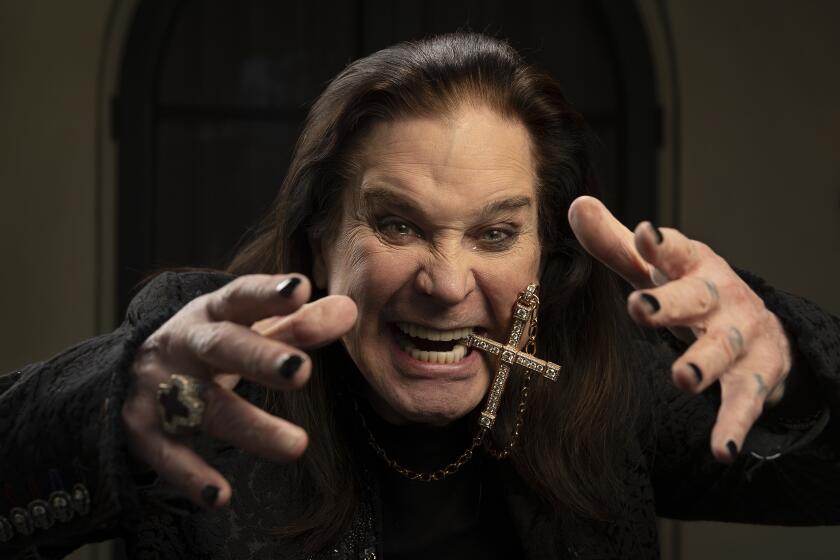Eclectic Party Swings Day, Night at Playboy Fest
- Share via
It wasn’t exactly musical yin and yang, but there definitely were two contrasting sides to the opening day program at the 21st annual Playboy Jazz Festival Saturday at the Hollywood Bowl. Once again--as so often in the past--both the music and the crowd reaction were distinctly divided between a daylight half and a nighttime half.
Nothing wrong with that, of course, since the Playboy Festival has always been as much about the event, the ambience and the weather as it has been about the music itself. And Saturday’s program was no exception.
The first of the festival’s two days unfolded with the blending of high points and occasional lag times typical of a daylong party with friends. As such, the daylight segment had a kickback quality, with people arriving gradually, arranging their picnic settings, conversing casually and even--on occasion--paying attention to the music.
What they heard varied widely, a reflection of this year’s especially eclectic programming. The concert-opening program by the L.A. Multi-School Jazz band was filled with youthful spirit, the solid playing of the ensemble a reflection of the determined work that director Reggie Andrews has done with this talented aggregation of young players.
The Cos of Good Music IV, the latest installment of master of ceremonies Bill Cosby’s all-star bands, contained enough quality artists to produce a sterling set. The choice of music was at best tepid, however, and the primary attraction of the performance was the soloing of saxophonists James Carter and Chico Freeman, guitarist Kevin Eubanks and pianist Benny Green.
But Cosby’s failure to identify the individual members of the band was mystifying--as was his failure to say anything about the recent passing of Mel Torme (although the Festival Program guide did include a timely mention of the late singer).
The first emotional peak of the daylight program was delivered by Cuban piano master Chucho Valdes. Although he chose to emphasize the flashy, rhapsodic aspect of his piano work rather than the turbulent rhythms he is so capable of playing, his music was so filled with propulsive energy that it was virtually irresistible. And, for the first time, the crowd’s attention was distracted from the social events of the afternoon.
Jon Hendricks & Annie Ross, performing a set that might have been more compelling in a nightclub, didn’t sustain much interest, however, until the final tunes in their program, when they dipped into the high quality hits of the original Lambert, Hendricks & Ross group. And Hendricks, in particular, sounded every bit as musically adventurous as he did in the years when the trio’s versions of “Moanin’,” “Centerpiece,” “Cloudburst” and “Jumpin’ at the Woodside” first hit the jazz audience.
Like Hendricks & Ross, saxophonist Joshua Redman--the one solid, straight-ahead, no-nonsense jazz artist on the bill--might have been more effective in a smaller arena. Nor was he aided by the fact that the audio was cranked up to near-painful levels. But Redman played superbly throughout, especially so in his renderings of “Summertime” and “Eleanor Rigby.”
The transition time between the daylight and nighttime portions of the festival began with the Cherry Poppin’ Daddies. One might have expected the revivalist Swing band from Oregon to start the audience-reaction segment of the program. But the band’s music was too unrelentingly locked into repetitious tempos, the songs too indecipherable to generate much reaction.
The in-between period also impacted Brazilian singer-songwriter Ivan Lins, easily the most musically provocative act of the day. As twilight began, the crowd was clearly in the mood for some foot-tapping funk. And, although Lins tried a few times to engage the crowd with a sing-along, the music--filled with subtle harmonies underscoring his superb songs and passionate vocals--simply didn’t have the impact it might have under different circumstances. Too bad, since Lins is one of the world’s finest musical artists, and clearly deserved a better hearing.
With nightfall and the appearance of singer Dianne Reeves, the crowd got what it wanted, and the final, let’s-have-fun segment of the festival began. The conga lines were already forming by the time Reeves hit her second song, and continued to grow throughout a set which, despite its high-energy quotient, still managed to reveal--notably during “Love for Sale”--Reeves’ sterling abilities.
The final performers, saxophonist Grover Washington Jr. and blues guitarist Buddy Guy, provided the rhythmic soundtrack for the day’s climactic party time, as the aisles were filled with happy dancers. But, as with Reeves, there was a kind of subtext, as well, with Washington showing great sensitivity playing soprano saxophone on a slow blues, and Guy offering an object display of some of the essential root music sources of rock ‘n’ roll. All things considered, they offered up an appropriate finale for a day that, in its segmented fashion, had a little something for everyone.
More to Read
The biggest entertainment stories
Get our big stories about Hollywood, film, television, music, arts, culture and more right in your inbox as soon as they publish.
You may occasionally receive promotional content from the Los Angeles Times.










